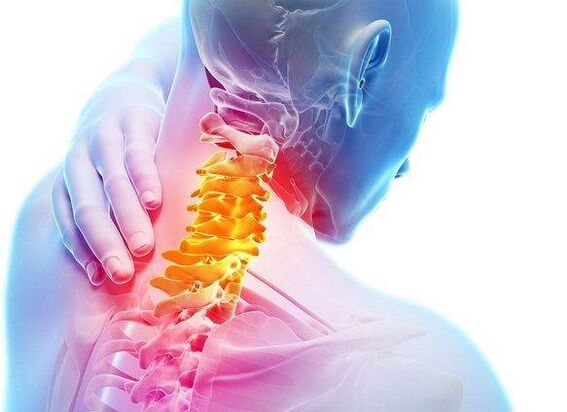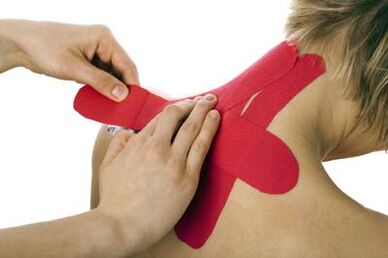Office staff and sedentary lifestyle features that prefer to relax in front of a TV or behind a monitor screen often cause osteochondrosis. In this article, we will consider which osteochondria is in the cervical spine, the main causes of the disease, its symptoms and stages, treatments, and answer other questions in patients with osteochondria.

The osteocartilage process affects any spine or several at a time. The lumbar and cervical vertebrae are most affected by pathology because the anatomy of human bones is most susceptible to loading. The consequences of spinal osteocartilage degeneration in the cervical area can bring the greatest inconvenience and potential complications, as the neck is a region rich in neurologic highways, many of which feed the brain directly. Furthermore, when squeezed with damaged vertebrates, the nerve roots provide hand and shoulder sensitivity and motor activity, which can give a variety of symptomatic conditions.
Signs of cervical osteochondrosis depend on the pathological impact of the body system:
- The disruption of blood circulation due to pressure from the vertebral artery determines most of the symptoms complexes in the brain.
- Compression from the roots of the vertebrate gives pictures of peripheral neuropathy.
- Clamping of the spinal cord region is related to severe neuropathology found in advanced cases.
Below, consider general clinics for cervical osteochondrosis. Pain on the head, neck and back of the collar area. This is the most common symptom. The pain positioning can be expanded, affecting the shoulders, clavicle area, chest, and turning into a nervous head migraine. The nature of the pain depends on the location of the lesion and the severity of the pathology. At first, the pain can quickly and instantly, gradually become chronic and sore. At the moment of intensification, the pain begins to shoot, the tone of the neck muscles increases, and the movement of the head is limited. Usually, the pain of cervical osteochondrosis can be located behind the sternum, in which case many patients take this symptom of angina.
Noise, sound, ears are filled
These symptoms usually reduce hearing. These phenomena are associated with reduced blood flow from the vertebral artery to the vestibular device. The complex of these symptoms is called cochlear implant or snail syndrome, and it is always possible to determine its association with the cervical vertebrae. A specific feature of differentiation is that after staying in a position for a long time, the noise, congestion and ringing in the ears can be felt when changing the position.
Dizziness
Dizziness is also caused by invading the blood flow of the inner ear organs, thus ensuring body balance. Nystagmus often adds to dizziness - any fluctuations in the eye's pupils are to the side.
Insufficient air
This feeling occurs in stimulation at the end of the diaphragmagragmatic nerve. It is an integral part of the cervical nerve bundle, involved in the regulation of breathing, its depth and frequency. The patient complained that he could not breathe all over the chest. In some cases, symptoms can exacerbate severe breathing and suffocation. For the same reason, breathing stops at night and exhale. The disadvantages of oxygen caused by respiratory problems are ultimately the cause of increased fatigue, the reduction of concentration and memory problems.
nausea
It comes with the Belching Air. It is also due to blood circulation problems in certain areas of the brain and inner ear. Nausea is sometimes observed due to tenacious vomiting caused by head and body movements. The result of frequent nausea and vomiting is reduced appetite, weight loss, and digestive failure.
Vision problems

"flies" in the eyes, decreased vision, fog in front of the eyes - these are symptoms of vision due to ischemia in the brain area. Vision in patients with osteochondrosis is less common because the lack of blood supply in the spinal canal system is compensated by blood flow from the carbon artery system. Glasses in the eye muscles and treatment of gymnastics do not solve the problem and usually improves after treating osteochondrosis.
Green symptoms
Usually, this may be the only symbol indicating cervical osteochondrosis. They are expressed as a feeling of sweating, dryness and a lump in the throat, with difficulty swallowing. Symptoms are related to compression of the nerve plexus responsible for the pharyngeal nerve. It is necessary to distinguish this manifestation from similar clinics for inflammation or tumors.
How to treat cervical osteochondral disease
The described spinal state is a very serious pathology that leads to disability due to serious diseases of brain circulation and death. So, by self-assessment, you shouldn't do this if you experience this symptom. According to the doctor's regulations, osteochondrosis was treated in the hospital and at home. In the initial stages, treatment of cervical osteochondrosis is conservative and includes medication prescriptions: nonsteroidal anti-inflammatory drugs, anesthetics, hormone drugs, vitamin complexes, cartilage protein ingestants - all of which can relieve inflammation, pain, pain, improve soft tissue and parterage and partialage verteprae verteprae verteprae verteprae verteprae verteprae verteprae verteprae verteprae verteprae verteprae verteprae verteprae verteprae verteprae verteprae verteprae verteprae verteprae verteprae verteprae verteprae verteprae verteprae verteprae verteprae verteprae verteprae verteprae verteprae verteprae verteprae verteprae verteprae verteprae verteprae verteprae verteprae verteprae verteprae verteprae verteprae verteprae verteprae verteprae verteprae verteprae verteprae verteprae verteprae verteprae verteprae verteprae verteprae verteprae verteprae verteprae verteprae verteprae verteprae verteprae verteprae verteprae verteprae verteprae verteprae verteprae verteprae verteprae verteprae verteprae verteprae verteprae verteptace.
In the acute period, as the pain subsides, the medication is prescribed in the form of an injection and the patient enters the tablet. Physical therapy, massage, exercise, and medication courses that are usually prescribed in the relief phase. In difficult circumstances, osteochondrosis is treated surgically.
Cervical spine diagram
Osteocartilage degeneration in the cervical vertebrae (Hondroz) is a degenerative nutritional injury to the vertebrae disc, which damages the joints in the wheels, vertebrae and cervical vertebrae area, and the decrease in the height of the disc was observed. If not treated, the disease can cause headaches, circulatory diseases and even hernia. Like osteoporosis, this disease occurs due to invasion of mineral metabolism, so bones and joints become longer lasting. Osteochondrosis can cause cervical instability (symptoms and treatments are similar to chondrosis, but with many characteristics), often accompanied by displacement of the vertebrae. This in turn accelerates the development of osteocartilage degeneration and destroys vertebrates.
The main causes of osteochondrosis:
- Improper nutrition and excessive weight;
- Violation of posture, scoliosis, rheumatism, flat feet;
- Seated lifestyle: sedentary work (driver, office staff), lack of physical fatigue, etc. ;
- Neck injury, spinal injury;
- Excessive physical exercise and unusual physical condition;
- Neurological tension, frequent stress;
- The development of hereditary susceptible diseases;
- Incorrect development of the cervical spine.

Most of the above causes can cause load on the cervical spine, which can lead to muscle spasms. Therefore, the blood circulation process is disturbed and the effectiveness of the metabolic process is reduced, resulting in degenerative changes. The structure of the intervertebral discs changes, they are thinned and deformed beyond the spine. Osteochondrosis is usually caused by progressive discs that spread to adjacent vertebrae or bone tissue. It usually occurs during prolonged physical exercises on the waist and cervix, almost never touching the chest. Development, osteochondrosis goes through several stages characterized by certain signs and symptoms. We will consider these phases below.
Osteocartilage degeneration in the first degree (preclinical stage) of the cervical area
Usually, only a slight smoothness of cervical spondylosis is observed during the initial stages of disease development, and the patient experiences pain as the head turns and tilts, tension and rapid fatigue of the muscles in the back and lower back. At this stage, osteochondrosis can be cured without medication, which is enough to change nutrition, perform exercise and other events.
Osteochondrosis 2 degrees
In the second stage between the vertebrae, instability is observed, and the patient begins to interfere with more severe pain, which regularly sends him to his hands or shoulders, and the pain also increases with the twists and tilting of the head. Patients begin to notice a decrease in rapid fatigue, lack of mentality, performance levels and headache levels.
Osteochondrosis 3 degrees
At this stage, the pain begins to intensify and it not only happens around the neck, but also reaches to his hand on his shoulders. As the hernia of the intervertebral disc begins to form, the muscles of the hand become weaker and numbness is observed. In this case, the diagnosis revealed a small mobility in the cervical region. The patient is worried about dizziness and weakness.
Osteochondrosis 4 degrees
In the final stage, the disc is destroyed and replaced by connective tissue. The pathological process immediately affects several parts of the ridge, which may be in different stages of destruction. In patients, coordination, dizziness and pain are violated, noise in the ears and other diseases. Even the initial stage of the disease can be determined based on the following signs:
- Skeleton of osteochondrosis in the cervical area
- Neck, nape, shoulder or arm pain;
- weakness of the hand;
- tightness and pain during head movements;
- General weaknesses, fatigue, coordination disorders, dizziness;
- Reduce the acuity of vision and hearing, and numbness of language.

One of the most common signs is dizziness in the degeneration of the cervical vertebrae. Meanwhile, dizziness can be accompanied by noise and sound in the ear (reduced acuity), disorientation, migraines, and sensations of nausea and vomiting. Furthermore, it is doctors who determine how to treat these symptoms that people should not try to get rid of dizziness by folk methods. Another unpleasant consequence is frequent headaches, especially in women. Migraines can occur several times a day, causing unpleasant and painful sensations. Signs of cervical disease are slightly different from osteochondria in other spinal columns, i. e. , the vertebrae of the neck is close to each other, the height of the intervertebral discs is small, and even a smaller degeneration can cause complications.
Symptoms of cervical bone and cartilage in the brain
As osteocartilage degeneration develops, blood flows through arteries compressed by the vertebrae edge to the brain trunk, lowering. As a result, blood circulation in the brain is violated. Among patients, neurotic diseases were observed: irritability, anxiety, frequent emotional changes, dissatisfaction, insomnia, and decreased ability to focus. In some cases, anger, fear, desire may occur. Vasospasm can cause drowsiness, headaches, ear noise, and the appearance of the point in front of the eyes. In this case, the following worsening symptoms occur: dizziness, instability, nausea, and vomiting in some cases.
Treatment of cervical vertebrae bone marrow disease
To treat diseases such as osteochondrosis, various methods are used: medications, physical therapy, cervical chest massage, for brain blood supply and therapeutic gymnastics, and maintaining proper nutrition. Although women are more likely to have headaches and limb numbness in the disease, treatment for cervical osteochondrosis in women is no different from that in men: the same medications and exercise are prescribed.
Diagnostic method
Experienced doctors can easily diagnose cervical osteochondrosis because of the characteristic clinical conditions of the disease. To determine the neglect and prevalence of pathological processes, many other tests were prescribed for patients:
- Radiography - Mobility and arrangement of vertebrae are changed, vertebrae cracks are reduced, saline sediments are determined;
- Computed tomography - You can see gaps, changes in disk height, instability of vertebrae, compression of nerve fibers and compression of spinal cord;
- Magnetic Resonance Imaging – Enables you to accurately view pathological changes and determine the condition of blood flow and nerve roots.
Usually, cervical vertebrae only is enough, and more expensive methods are used for confusing and unclear cases.

Medical Sports
Ensure exercise for cervical osteochondrosis is strictly performed during the remission process, and the acute phase of exercise may lead to a decrease in the patient's condition. All physical therapy exercises will be reduced to the turn and inclination of the head. It is important to perform actions slowly without sudden movements. If pain occurs - stop the course and seek advice from experts.
If a person has a tendency to develop pathology, he needs to visit experts regularly and conduct research. This will help identify the disease early and start treatment in time. For example, the symptom of cervical osteochondrosis described in the article affects the cervical spine and begins to literally destroy them. What will happen is easy to guess.


















